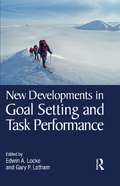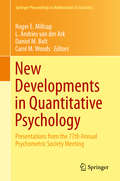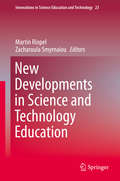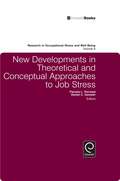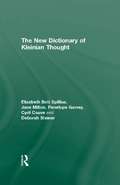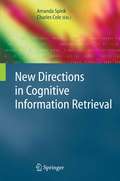- Table View
- List View
New Developments in Goal Setting and Task Performance
by Edwin A. Locke Gary P. LathamThis book concentrates on the last twenty years of research in the area of goal setting and performance at work. The editors and contributors believe goals affect action, and this volume has a lineup of international contributors who look at the recent theories and implications in this area for IO psychologists and human resource management academics and graduate students.
New Developments in Home Care Services for the Elderly: Innovations in Policy, Program, and Practice
by Lenard W KayeThis anthology responds to the recurring call for quality in home care service provision. It presents to agency administrators, managers, supervisors, and front line service providers a set of the most up-to-date policy, program, and practice developments in the field. Each contributor to New Developments in Home Care Services for the Elderly explores issues of client/staff diversity and the challenges associated with working with clients grappling with disabling conditions.Contributors in New Developments in Home Care Services for the Elderly explore issues of client/staff diversity and the challenges associated with working with clients grappling with various disabling conditions. Topics addressed include: alternative organizational models in home care the importation of high technology services into the home legal and ethical issues in home health care counseling homebound clients and their families clinical assessment tools and packages case management and the home care client home care entitlements and benefits evaluating and monitoring the effectiveness of in-home care marketing home health care services home care service experiences in other countriesNew Developments in Home Care Services for the elderly covers a continuum of care ranging from housekeeping services to self-care education, teaching, and training services to nursing and medically related services. Consequently, the information contained within this volume is of immediate relevance to a multidisciplinary audience having both direct (field) and indirect (office) service responsibilities in the home care organization. Social workers, nurses, business administrators, and public health professionals will find this an invaluable guide for providing effective home care services.
New Developments in Home Care Services for the Elderly: Innovations in Policy, Program, and Practice
by Lenard W KayeThis anthology responds to the recurring call for quality in home care service provision. It presents to agency administrators, managers, supervisors, and front line service providers a set of the most up-to-date policy, program, and practice developments in the field. Each contributor to New Developments in Home Care Services for the Elderly explores issues of client/staff diversity and the challenges associated with working with clients grappling with disabling conditions.Contributors in New Developments in Home Care Services for the Elderly explore issues of client/staff diversity and the challenges associated with working with clients grappling with various disabling conditions. Topics addressed include: alternative organizational models in home care the importation of high technology services into the home legal and ethical issues in home health care counseling homebound clients and their families clinical assessment tools and packages case management and the home care client home care entitlements and benefits evaluating and monitoring the effectiveness of in-home care marketing home health care services home care service experiences in other countriesNew Developments in Home Care Services for the elderly covers a continuum of care ranging from housekeeping services to self-care education, teaching, and training services to nursing and medically related services. Consequently, the information contained within this volume is of immediate relevance to a multidisciplinary audience having both direct (field) and indirect (office) service responsibilities in the home care organization. Social workers, nurses, business administrators, and public health professionals will find this an invaluable guide for providing effective home care services.
New Developments in Psychological Choice Modeling (ISSN #Volume 60)
by G. De Soete H. Feger K. C. KlauerA selection of 15 papers on choice modeling are presented in this volume. These papers result from research in the social and behavioral sciences and in economics. The models, some deterministic, some probabilistic, represent recent developments in the tradition of Thurstone's Law of Comparative Judgement, Coombs' unfolding theory and multidimensional scaling. The theoretical contributions and several applications to voting behaviour, consumer research and preference rankings show the important progress made in psychological choice modeling during the last few years.
New Developments in Psychometrics: Proceedings of the International Meeting of the Psychometric Society IMPS2001. Osaka, Japan, July 15–19, 2001
by Haruo Yanai Jacqueline J. Meulman Akinori Okada Kazuo Shigemasu Yutaka KanoAt the International Meeting of the Psychometric Society in Osaka, Japan, more than 300 participants from 19 countries gathered to discuss recent developments in the theory and application of psychometrics. This volume of proceedings includes papers on methods of psychometrics such as the structural equation model and item response theory. The book is in eight major sections: keynote speeches and invited lectures; structural equation modeling and factor analysis; IRT and adaptive testing; multivariate statistical methods; scaling; classification methods; and independent and principal component analysis. The 80 papers collected here provide a valuable source of information for all who are concerned with psychometrics, mathematical and statistical applications, and data analysis in psychological and behavioral sciences.
New Developments in Quantitative Psychology: Presentations from the 77th Annual Psychometric Society Meeting (Springer Proceedings in Mathematics & Statistics #66)
by Roger E. Millsap, L. Andries Ark, Daniel M. Bolt and Carol M. WoodsThe 77th Annual International Meeting of the Psychometric Society (IMPS) brought together quantitative researchers who focus on methods relevant to psychology. The conference included workshops, invited talks by well-known scholars, and presentations of submitted papers and posters. It was hosted by the University of Nebraska-Lincoln and took place between the 9th and 12th of July, 2012. The chapters of this volume are based on presentations from the meeting and reflect the latest work in the field. Topics with a primarily measurement focus include studies of item response theory, computerized adaptive testing, cognitive diagnostic modeling, and psychological scaling. Additional psychometric topics relate to structural equation modeling, factor analysis, causal modeling, mediation, missing data methods, and longitudinal data analysis, among others. The papers in this volume will be especially useful for researchers (graduate students and other quantitative researchers) in the social sciences who use quantitative methods, particularly psychologists. Most readers will benefit from some prior knowledge of statistical methods in reading the chapters.
New Developments in Science and Technology Education (Innovations in Science Education and Technology #23)
by Martin Riopel Zacharoula SmyrnaiouThis book explores the beneficial impact of pedagogically updated practices and approaches in the teaching of science concepts as well as elaborates on future challenges and emerging issues that address Science and Technology Education. By pointing out new research directions it informs educational practices and bridges the gap between research and practice providing information, ideas and new perspectives. The book also promotes discussions and networking among scientists and stakeholders such as researchers, professors, students and companies developing educational software and ICT tools. The volume presents papers from the First International Conference on “New Developments in Science and Technology Education” (1st NDSTE) that was structured around four main thematic axes Modern Pedagogies in Science and Technology Education, New Technologies in Science and Technology Education, Teaching and Learning in the light of Inquiry learning Methods and Interest, Attitude and Motivation in Science.
New Developments in Theoretical and Conceptual Approaches to Job Stress (Research in Occupational Stress and Well-being #8)
by Daniel C. Ganster Pamela L. PerreweThe objective of this series is to promote theory and research in the increasingly growing area of occupational stress, health and well being, and in the process, to bring together and showcase the work of the best researchers and theorists who contribute to this area. Questions regarding work stress span many disciplines and many specialized journals. It is increasingly difficult to track, and even harder to integrate, the work from these diverse fields. Our plan is to provide a multidisciplinary and international collection that gives a thorough and critical assessment of knowledge, and major gaps in knowledge, on occupational stress and well being. Furthermore, because we will be publishing monograph-length conceptual papers, our interest is in promoting the careful development of truly path-breaking contributions that can significantly advance theory and provide specific directions for future work.
The New Dictionary of Kleinian Thought
by Elizabeth Bott Spillius Jane Milton Penelope Garvey Cyril Couve Deborah SteinerThe New Dictionary of Kleinian Thought provides a comprehensive and wholly accessible exposition of Kleinian ideas. Offering a thorough update of R.D. Hinshelwood’s highly acclaimed original, this book draws on the many developments in the field of Kleinian theory and practice since its publication. The book first addresses twelve major themes of Kleinian psychoanalytic thinking in scholarly essays organised both historically and thematically. Themes discussed include: unconscious phantasy, child analysis the paranoid schizoid and depressive positions, the oedipus complex projective identification, symbol formation. Following this, entries are listed alphabetically, allowing the reader to find out about a particular theme - from Karl Abraham to Whole Object - and to delve as lightly or as deeply as needed. As such this book will be essential reading for psychoanalysts, psychotherapists as well as all those with an interest in Kleinian thought.
The New Dictionary of Kleinian Thought
by Elizabeth Bott Spillius Jane Milton Penelope Garvey Cyril Couve Deborah SteinerThe New Dictionary of Kleinian Thought provides a comprehensive and wholly accessible exposition of Kleinian ideas. Offering a thorough update of R.D. Hinshelwood’s highly acclaimed original, this book draws on the many developments in the field of Kleinian theory and practice since its publication. The book first addresses twelve major themes of Kleinian psychoanalytic thinking in scholarly essays organised both historically and thematically. Themes discussed include: unconscious phantasy, child analysis the paranoid schizoid and depressive positions, the oedipus complex projective identification, symbol formation. Following this, entries are listed alphabetically, allowing the reader to find out about a particular theme - from Karl Abraham to Whole Object - and to delve as lightly or as deeply as needed. As such this book will be essential reading for psychoanalysts, psychotherapists as well as all those with an interest in Kleinian thought.
The New Dictionary Of Kleinian Thought
by Elizabeth Bott-Spillius Jane Milton Penelope Garvey Cyril Couve Deborah SteinerThe New Dictionary of Kleinian Thought provides a comprehensive and wholly accessible exposition of Kleinian ideas. Offering a thorough update of R. D. Hinshelwood s highly acclaimed original, this book draws on the many developments in the field of Kleinian theory and practice since its publication. The book first addresses twelve major themes of Kleinian psychoanalytic thinking in scholarly essays organised both historically and thematically. Themes discussed include: unconscious phantasy, child analysis the paranoid schizoid and depressive positions, the oedipus complex projective identification, symbol formation. Following this, entries are listed alphabetically, allowing the reader to find out about a particular theme - from Karl Abraham to Whole Object - and to delve as lightly or as deeply as needed. As such this book will be essential reading for psychoanalysts, psychotherapists as well as all those with an interest in Kleinian thought. "
New Digital Technology in Education: Conceptualizing Professional Learning for Educators
by Wan NgThis book addresses the issues confronting educators in the integration of digital technologies into their teaching and their students’ learning. Such issues include a skepticism of the added value of technology to educational learning outcomes, the perception of the requirement to keep up with the fast pace of technological innovation, a lack of knowledge of affordable educational digital tools and a lack of understanding of pedagogical strategies to embrace digital technologies in their teaching. This book presents theoretical perspectives of learning and teaching today’s digital students with technology and propose a pragmatic and sustainable framework for teachers’ professional learning to embed digital technologies into their repertoire of teaching strategies in a systematic, coherent and comfortable manner so that technology integration becomes an almost effortless pedagogy in their day-to-day teaching. The materials in this book are comprised of original and innovative contributions, including empirical data, to existing scholarship in this field. Examples of pedagogical possibilities that are both new and currently practised across a range of teaching contexts are featured.
New Dimensions in Body Psychotherapy (UK Higher Education OUP Humanities & Social Sciences Counselling and Psychotherapy)
by Nick TottonThere is currently an explosion of interest in the field of body psychotherapy. This is feeding back into psychotherapy and counselling in general, with many practitioners and trainees becoming interested in the role of the body in holding and releasing traumatic patterns. This collection of ground-breaking work by practitioners at the forefront of contemporary body psychotherapy enriches the whole therapy world. It explores the leading edge of theory and practice, including: Neuroscientific contributionsEmbodied countertransferenceMovement patterns and infant developmentFreudian and Jungian approachesContinuum MovementEmbodied-Relational TherapyProcess WorkBody-Mind Centering® Developmental Somatic PsychotherapyTrauma workNew Dimensions in Body Psychotherapy is an essential contribution to the ‘turn to the body’ in modern psychotherapy.Contributors: Jean-Claude Audergon, Katya Bloom, Roz Carroll, Emilie Conrad, Ruella Frank, Linda Hartley, Gottfried Heuer, Peter Levine, Yorai Sella, Michael Soth, Nick Totton, David Tune.
New Dimensions in Community Well-Being (Community Quality-of-Life and Well-Being)
by Patsy Kraeger Scott Cloutier Craig TalmageThis volume addresses new innovations in quality of life and well-being from the perspectives of the individual, society and community. It aggregates the perspectives, research questions, methods and results that consider how quality of life is influenced in our modern society. Chapters in this volume present theoretical and practical examples on different aspects of quality of life and community well-being representing American, European, Native American and African perspectives. This volume is of interest to scholars in sociology, psychology, economy, philosophy, health research as well as practitioners across the social sciences.
New Directions for Catholic Social and Political Research: Humanity vs. Hyper-Modernity
by Guido Giacomo PreparataThis book offers scholars who ground their research in compassion and pacifism a new framework for the socio-political analysis of current global events. By tackling a broad range of critical themes in various disciplines, the essays compose a critical narrative of the ways in which power and violence shape society, culture, and belief. In addition to the contemporary dynamics of international economics, political murder, and the rhetorical antagonism between Christianity and Islam, the book addresses cultural strife in the West, the societal effects of neoconservative hegemony in the United States and the world, and the overall question of religious credence in connection with political action. All such topics are discussed with a view toward providing solutions and policies that are informed by a comprehensive desire to resist violence and war, on the one hand, and to foment cohesion and harmony at the community level, on the other.
New Directions for Research in L2 Writing (Studies in Writing #11)
by Sarah Ransdell and Marie-Laure BarbierThis book describes the current psycholinguistic research being conducted internationally on better understanding second language (L2) writing. It is based on an experimental research tradition arising from recent progress made in methodology, technology and theory in both native and second language writing. It is unique in that it is specifically geared to better understanding L2 writing and how it relates to L1 writing research in the psycholinguistic tradition.
New Directions for Situated Cognition in Mathematics Education (Mathematics Education Library #45)
by Anne Watson Peter WinbourneThis book draws together a range of papers by experienced writers in mathematics education who have used the concept of situated cognition in their research within recent years. No other books are available which take this view specifically in mathematics education. Thus it provides an up-to-date overview of developments and applications to which other researchers can refer and which will inspire future research.
New Directions in Aesthetics, Creativity and the Arts
by Paul Locher Colin Martindale Leonid DorfmanThe contributing authors to this book, all pre-eminent scholars in their fields, present their current thinking about the processes that underlie creativity and aesthetic experience. They discuss established theory and research and provide creative speculation on future problems for inquiry and new approaches to conceptualising and investigating these phenomena. The book contains many new findings and ideas never before published or new by virtue of the novel context in which they are incorporated. Thus, the chapters present both new approaches to old problem and new ideas and approaches not yet explored by leading scholars in these fields. The first part of the book is devoted to understanding the nature of the perceptual/cognitive and aesthetic processes that occur during encounters with visual art stimuli in everyday settings, in museums and while watching films. Also discussed in Part I is how cultural and anthropological approaches to the study of aesthetic responses to art contribute to our understanding about the development of a culture's artistic canon and to cross-cultural aesthetic universals. Part II presents new dimensions in the study of creativity. Two approaches to the development of a comprehensive theory of creativity are presented: Sternberg's Investment Theory of Creativity and a systems perspective of creativity based on a metaindividual world model. Also covered are the factors that contribute to cinematic creativity and a film's cinematic success, and the complex nature of the creative processes and research approaches involved in the innovative product design necessitated by the introduction of electronics in consumer products. Part III deals with the application of concepts and models from cognitive psychology to the study of music, literary meaning and the visual arts. The contributors outline a model of the cognitive processes involved in real-time listening to music, investigate what readers are doing when they read a literary text, describe what research shows about the transfer of learning from the arts to non-arts cognition and discuss the kinds of thinking skills that emerge from the study of the visual arts by high school students. In Part IV, the authors focus on the interactive contribution of observers' personalities and affect states to the creation and perception of art. The chapters include a discussion of the internal mechanisms by which personality expresses itself during the making of and the response to art; the relationship between emotion and cognition in aesthetics, in terms of the interaction of top-down and bottom-up processes across the time course of an aesthetic episode; the affective processes that take place during pretend play and their impact on the development of creativity in children and the causes and consequences of listener's intense experiences while listening to music.
New Directions in Aesthetics, Creativity and the Arts
by Paul Locher Colin Martindale Leonid DorfmanThe contributing authors to this book, all pre-eminent scholars in their fields, present their current thinking about the processes that underlie creativity and aesthetic experience. They discuss established theory and research and provide creative speculation on future problems for inquiry and new approaches to conceptualising and investigating these phenomena. The book contains many new findings and ideas never before published or new by virtue of the novel context in which they are incorporated. Thus, the chapters present both new approaches to old problem and new ideas and approaches not yet explored by leading scholars in these fields. The first part of the book is devoted to understanding the nature of the perceptual/cognitive and aesthetic processes that occur during encounters with visual art stimuli in everyday settings, in museums and while watching films. Also discussed in Part I is how cultural and anthropological approaches to the study of aesthetic responses to art contribute to our understanding about the development of a culture's artistic canon and to cross-cultural aesthetic universals. Part II presents new dimensions in the study of creativity. Two approaches to the development of a comprehensive theory of creativity are presented: Sternberg's Investment Theory of Creativity and a systems perspective of creativity based on a metaindividual world model. Also covered are the factors that contribute to cinematic creativity and a film's cinematic success, and the complex nature of the creative processes and research approaches involved in the innovative product design necessitated by the introduction of electronics in consumer products. Part III deals with the application of concepts and models from cognitive psychology to the study of music, literary meaning and the visual arts. The contributors outline a model of the cognitive processes involved in real-time listening to music, investigate what readers are doing when they read a literary text, describe what research shows about the transfer of learning from the arts to non-arts cognition and discuss the kinds of thinking skills that emerge from the study of the visual arts by high school students. In Part IV, the authors focus on the interactive contribution of observers' personalities and affect states to the creation and perception of art. The chapters include a discussion of the internal mechanisms by which personality expresses itself during the making of and the response to art; the relationship between emotion and cognition in aesthetics, in terms of the interaction of top-down and bottom-up processes across the time course of an aesthetic episode; the affective processes that take place during pretend play and their impact on the development of creativity in children and the causes and consequences of listener's intense experiences while listening to music.
New Directions in Attribution Research: Volume 1
by J. H. Harvey W. J. Ickes R. F. KiddPublished in 1976, New Directions in Attribution Research is a valuable contribution to the field of Social Psychology.
New Directions in Attribution Research: Volume 1
by JOHN H. HARVEY, WILLIAM ICKES AND ROBERT F. KIDDPublished in 1976, New Directions in Attribution Research is a valuable contribution to the field of Social Psychology.
New Directions in Cognitive Information Retrieval (The Information Retrieval Series #19)
by Amanda Spink Charles ColeNew Directions in Cognitive Information Retrieval presents an exciting new direction for research into cognitive oriented information retrieval (IR) research, a direction based on an analysis of the user’s problem situation and cognitive behavior when using the IR system. This contrasts with the current dominant IR research paradigm which concentrates on improving IR system matching performance. The chapters describe the leading edge concepts and models of cognitive IR that explore the nexus between human cognition, information and the social conditions that drive humans to seek information using IR systems. Chapter topics include: Polyrepresentation, cognitive overlap and the boomerang effect, Multitasking while conducting the search, Knowledge Diagram Visualizations of the topic space to facilitate user assimilation of information, Task, relevance, selection state, knowledge need and knowledge behavior, search training built into the search, children’s collaboration for school projects, and other cognitive perspectives on IR concepts and issues.
New Directions in Consciousness Studies: SoS theory and the nature of time
by Chris NunnNew Directions in Consciousness Studies describes a range of fresh ideas which promise to significantly advance scientific understanding of human nature. Written in non-specialized language, the book draws upon concepts and research from history, philosophy, neuroscience and physics to delineate new approaches to the study of consciousness. Early chapters deal with a range of ideas about our nature, and suggest that mind can usefully be viewed as a type of dynamic landscape. The account shows how our minds relate to their societies, brains and bodies and how they differ from computers. Later chapters develop a theory of the basis of consciousness (SoS theory). Using the physical concept of ‘broken symmetry’ the author shows how conscious mind may be rooted in temporality; a view that is supported by the occurrence of a wide range of anomalous phenomena. Potentially valuable future lines of research are identified. This is a unique and engaging book that will appeal to students and academics in the field of consciousness studies and other readers with an interest in consciousness.
New Directions in Consciousness Studies: SoS theory and the nature of time
by Chris NunnNew Directions in Consciousness Studies describes a range of fresh ideas which promise to significantly advance scientific understanding of human nature. Written in non-specialized language, the book draws upon concepts and research from history, philosophy, neuroscience and physics to delineate new approaches to the study of consciousness. Early chapters deal with a range of ideas about our nature, and suggest that mind can usefully be viewed as a type of dynamic landscape. The account shows how our minds relate to their societies, brains and bodies and how they differ from computers. Later chapters develop a theory of the basis of consciousness (SoS theory). Using the physical concept of ‘broken symmetry’ the author shows how conscious mind may be rooted in temporality; a view that is supported by the occurrence of a wide range of anomalous phenomena. Potentially valuable future lines of research are identified. This is a unique and engaging book that will appeal to students and academics in the field of consciousness studies and other readers with an interest in consciousness.
